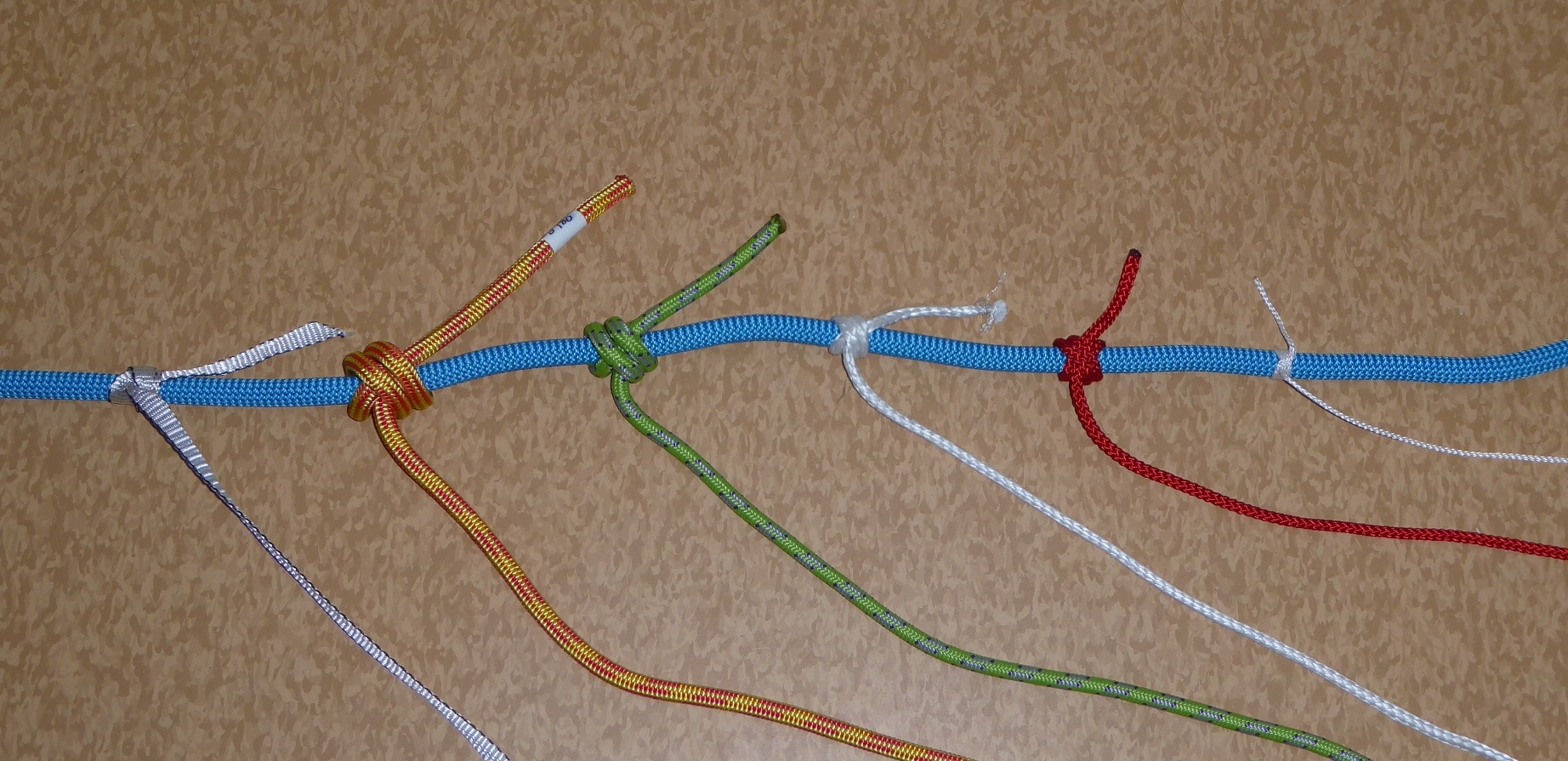Ezelius' adjustable hitches
The Ezelius' adjustable loop hitch and the Ezelius' adjustable grip hitch are presented in separate sections below. Both knots are based upon the same basic knot. The difference is that one ties on to the same rope, thus creating a loop, while the other version ties on to another rope. The knot is a kind of friction hitch/knot (slide and grip hitch). The Ezelius' adjustable hitches may be a little difficult to untie for some types of ropes.
Comparison to other knots
The Ezelius' adjustable hitches/knots excels on some slippery stiff polyamide (nylon) kernmantle cords made for climbing purposes. The Ezelius' adjustable hitches can get a grip while for example the following knots fail: the adjustable Cawley hitch (adjustable grip hitch) (number #1994 in The Ashley Book of Knots), the taut-line hitch (#1856), the midshipman's hitch (#1855) and the rolling hitch (#1734 and #1735). In this way the Ezelius' adjustable hitch is a useful addition to the friction knot family.
The Blake's hitch of the 5/3 version seems to have similar grip performance on some stiff and slippery kernmantle ropes of polyamide (nylon), but the Ezelius' knot might have an advantage in that it seems to be more secure and be more easy to dress (have all all turns stay in place) while tightening the knot.

Ezelius' adjustable loop hitch
Alternative names are Ezelius' adjustable eye hitch/knot and Ezelius' loop/eye.
The Ezelius' loop has a loop (an eye) that is fixed while loaded, but the size of the loop can be adjusted while unloaded. It can be used for example to put tension to tent lines or clothes-lines, to tye down aircraft and secure loads on vehicles.

The Ezelius' loop works well with numerous kinds of rope. In the image above the knot is has been made on the following types of cord, from left to right:
- 12-plaited Dyneema® SK78 ⌀ 4 mm (LIROS D-pro rope 4 mm)
- polyester band/webbing width 9 mm
- 8-plaited polyester ⌀ 2 mm
- 8-plaited polyester ⌀ 4 mm
- kernmantle polyamide ⌀ 5 mm
- kernmantle polyamide (PA6) ⌀ 6 mm (Simond 6 mm cordelette)
- kernmantle polyamide ⌀ 7 mm (Edelrid Powerloc expert SP 7 mm)
Instruction
Ezelius' loop is made by making two turns and stick the end under the turns as shown in the images below. The knot is tightened by hand in order to achieve the desired friction.





Ezelius' adjustable grip hitch
Alternative names are Ezelius' adjustable friction hitch/knot, Ezelius' slide and grip hitch and Ezelius' hitch/knot.
Ezelius' hitch connects one cord to another via a friction hitch. The cord may have the same or a smaller diameter than the cord it attaches to. While unloaded the knot can be moved up or down along the cord it attaches to.
The grip is produced when the attached cord is pulled along the cord it attaches to in one direction, not both directions.
The knot may be more difficult to untie if the cord it holds on to is soft.

Many kinds of ropes can be used to tye the Ezelius' hitch. In the image above the knot is has been used to knot on to a dymamic climbing rope (Simond ROCK+ ⌀ 10 mm), and the following cords were used, from left to right:
- polyester band/webbing width 9 mm
- kernmantle polyamide ⌀ 7 mm (Edelrid Powerloc expert SP 7 mm)
- kernmantle polyamide (PA6) ⌀ 6 mm (Simond 6 mm cordelette)
- 12-plaited Dyneema® SK78 ⌀ 4 mm (LIROS D-pro rope 4 mm)
- 8-plaited polyester ⌀ 4 mm
- 8-plaited polyester ⌀ 2 mm
Instruction
Ezelius' hitch is made by making two turns and stick the end under the turns as shown in the images below. The knot is tightened by hand in order to achieve the desired friction.





History
The Ezelius' adjustable loop hitch was invented by Kasper Ezelius (born 1969, Örebro, Sweden) in 2018 while trying to find something better than modifierad tältlineknop on page 160 in a book (Geoffrey Budworth and Richard Hopkins, 2010, Vilken knop?, ISBN 978-91-7401-107-4). Modifierad tältlineknop was a knot that he did not find very good, so he experimented in creating a knot that had good performance as a locking knot for a loop. The idea was to go "backwards" on the rope in order to create a lever that forced the standing part to make a curve instead of going straight through the lose part.